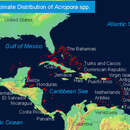en
names in breadcrumbs


The coral reefs in the eastern tropical Pacific have been most severly degraded by climatic events. Especially after the El Nino of 1982-1983. Many of these reefs have continued to deteriorate since then because coral recruitment has been sparse and sea urchins continue to erode away the framework of the coral. Coral bleaching (loss of zooxanthellae and/or pigment) has been increasingly wide-spread and frequent. In a survey of more than 2,000 sites in the British Virign Islands, it was found that over 95% of Acropora were dead in 1993.
US Federal List: threatened
CITES: appendix ii
IUCN Red List of Threatened Species: critically endangered
There really are not any negative effects that corals cause to humans. Sometimes they can damage or wreck a boat, but usually they are pretty harmless to humans
Acropora cervicornis house many creatures, some of which may be useful to the medical research field. Some of the species that live in the corals have already yeilded compounds active against inflammations, asthma, leukemia, tumors, heart disease, fungal and bacteria infections, and even viruses including HIV (Chadwick 1999). Staghorn corals are also of vital importance to the stabilization of coastlines, as fish habitats, and for the protection of our biodiversity (Nemoto 1992).
Staghorn corals use their nematocysts which are located on their tentacles for eating and gaining food. Surprisingly some Acropora species have actually been seen capturing live fish (Sisson 1973). Staghorn corals also eat planktonic animals which float by in the water (McGregor 1974).
Species of the genus -Acropora- are favorable to warm water marine environments. In particular, -Acropora cervicornis- is one of the primary reef building corals in the Caribbean (Birkeland 1997). These species are also located in the Great Barrier Reef of Australia (McGregor 1974).
Biogeographic Regions: atlantic ocean (Native ); pacific ocean (Native )
Acropora cervicornis like to live in warm, marine water close to the surface. The tropical western regions of the oceans are where there is most of the coral diversity of coral reef organisms (Birkeland 1997). The polyps that form the coral need tropical waters where the temperatures are higher than 20 degrees centigrade and there is adequate light. They also require a hard surface for which the coral polyps can settle. Staghorn corals, as well as all other corals, need very oxygenated water containing adequate supplies of small planktonic animals. Corals also need clear water, because apart from reducing the light, and heavy rain of sediment would smother them (McGregor 1974)
Aquatic Biomes: coastal
These corals commonly have tentacles in multiples of three, which is characteristic of all corals belonging to the subclass Zoantharia, also known as Hexacorallia (Encarta 1997). At night, the tiny fingerlike tentacles of the corals emerge. They pump themselves up with water and pop out like tiny stars all over a coral reef (Sargent 1991). The staghorn coral, -A. cervicornis-, grows into "antler-like branches" so the polyps are raised above the sand (McGregor 1974). Staghorn corals have nematocysts, which are stinging cells that are located on their tentacles. These stinging cells are necessary for a coral to obtain food (Sisson 1973).
Other Physical Features: ectothermic ; radial symmetry
As in all corals, the Staghorn Coral reproduces both sexually and asexually. The very first stage of reproduction is a sexually-caused stage of reef-building. This occurs when existing polyps expel millions of spermatoza into the water. Some of these gametes are drawn into other polyps that are nearby; the eggs that are produced there are then fertilized and larva develop and float away to produce new polyps. The larva, called planula, are extremely small and bulb-shaped. They are constantly changing shape as they swim/drift (Sisson 1973). They have a mouth at the upper end, which is the wider end with cilia like hairs all over them that are constantly beating and help support them to the surface. The planula that survive predators while floating through the water settle on a suitable hard surface in warm water and attach themselves by spreading out into a disk (Sisson 1973). Once they land here, they begin to secrete a white starlike outer skeleton which permanently cements it to a spot and develop tentacles and grow into mature polyps. Once the first skeletons are built, the founders, or the sexually produced polyps, multiply by asexual methods. Acropora grow branches, which are also known as buds, that become the daughter polyps, which then bud more daughters (McGregor 1974).
Parental Investment: no parental involvement